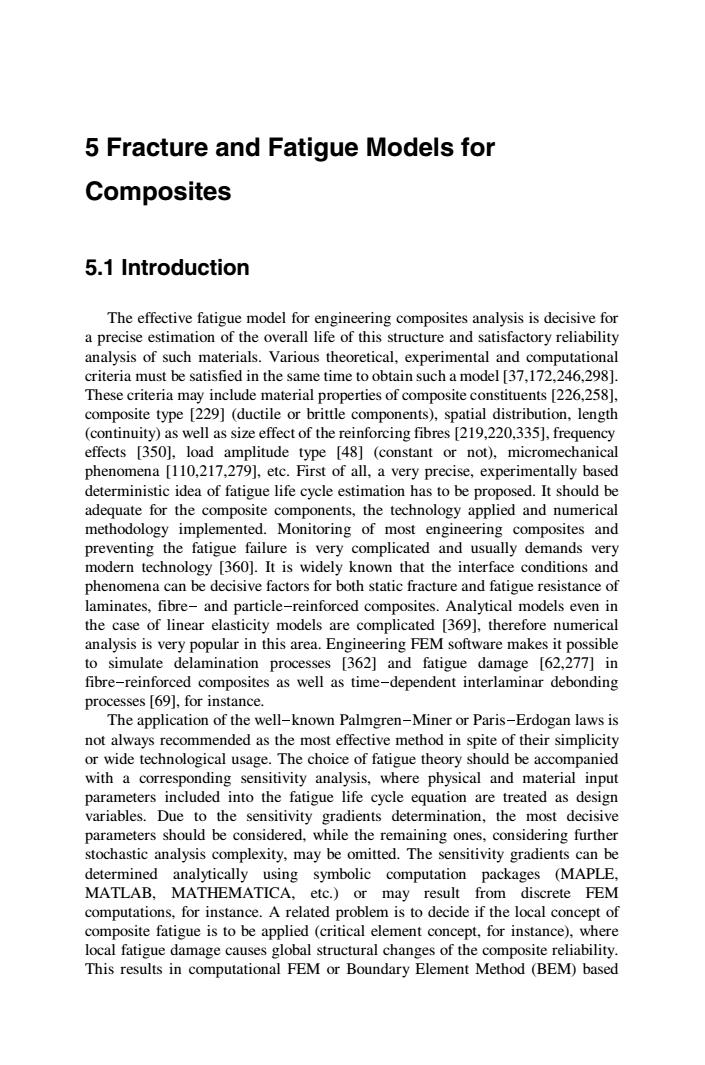正在加载图片...

5 Fracture and Fatigue Models for Composites 5.1 Introduction The effective fatigue model for engineering composites analysis is decisive for a precise estimation of the overall life of this structure and satisfactory reliability analysis of such materials.Various theoretical,experimental and computational criteria must be satisfied in the same time to obtain such a model [37,172,246,2981. These criteria may include material properties of composite constituents [226,258], composite type [229](ductile or brittle components),spatial distribution,length (continuity)as well as size effect of the reinforcing fibres [219,220,335],frequency effects [350],load amplitude type [48](constant or not),micromechanical phenomena [110,217,279],etc.First of all,a very precise,experimentally based deterministic idea of fatigue life cycle estimation has to be proposed.It should be adequate for the composite components,the technology applied and numerical methodology implemented.Monitoring of most engineering composites and preventing the fatigue failure is very complicated and usually demands very modern technology [360].It is widely known that the interface conditions and phenomena can be decisive factors for both static fracture and fatigue resistance of laminates,fibre-and particle-reinforced composites.Analytical models even in the case of linear elasticity models are complicated [369],therefore numerical analysis is very popular in this area.Engineering FEM software makes it possible to simulate delamination processes [362]and fatigue damage [62,277]in fibre-reinforced composites as well as time-dependent interlaminar debonding processes [69],for instance. The application of the well-known Palmgren-Miner or Paris-Erdogan laws is not always recommended as the most effective method in spite of their simplicity or wide technological usage.The choice of fatigue theory should be accompanied with a corresponding sensitivity analysis,where physical and material input parameters included into the fatigue life cycle equation are treated as design variables.Due to the sensitivity gradients determination,the most decisive parameters should be considered,while the remaining ones,considering further stochastic analysis complexity,may be omitted.The sensitivity gradients can be determined analytically using symbolic computation packages (MAPLE, MATLAB,MATHEMATICA,etc.)or may result from discrete FEM computations,for instance.A related problem is to decide if the local concept of composite fatigue is to be applied (critical element concept,for instance),where local fatigue damage causes global structural changes of the composite reliability. This results in computational FEM or Boundary Element Method (BEM)based5 Fracture and Fatigue Models for Composites 5.1 Introduction The effective fatigue model for engineering composites analysis is decisive for a precise estimation of the overall life of this structure and satisfactory reliability analysis of such materials. Various theoretical, experimental and computational criteria must be satisfied in the same time to obtain such a model [37,172,246,298]. These criteria may include material properties of composite constituents [226,258], composite type [229] (ductile or brittle components), spatial distribution, length (continuity) as well as size effect of the reinforcing fibres [219,220,335], frequency effects [350], load amplitude type [48] (constant or not), micromechanical phenomena [110,217,279], etc. First of all, a very precise, experimentally based deterministic idea of fatigue life cycle estimation has to be proposed. It should be adequate for the composite components, the technology applied and numerical methodology implemented. Monitoring of most engineering composites and preventing the fatigue failure is very complicated and usually demands very modern technology [360]. It is widely known that the interface conditions and phenomena can be decisive factors for both static fracture and fatigue resistance of laminates, fibre- and particle-reinforced composites. Analytical models even in the case of linear elasticity models are complicated [369], therefore numerical analysis is very popular in this area. Engineering FEM software makes it possible to simulate delamination processes [362] and fatigue damage [62,277] in fibre-reinforced composites as well as time-dependent interlaminar debonding processes [69], for instance. The application of the well-known Palmgren-Miner or Paris-Erdogan laws is not always recommended as the most effective method in spite of their simplicity or wide technological usage. The choice of fatigue theory should be accompanied with a corresponding sensitivity analysis, where physical and material input parameters included into the fatigue life cycle equation are treated as design variables. Due to the sensitivity gradients determination, the most decisive parameters should be considered, while the remaining ones, considering further stochastic analysis complexity, may be omitted. The sensitivity gradients can be determined analytically using symbolic computation packages (MAPLE, MATLAB, MATHEMATICA, etc.) or may result from discrete FEM computations, for instance. A related problem is to decide if the local concept of composite fatigue is to be applied (critical element concept, for instance), where local fatigue damage causes global structural changes of the composite reliability. This results in computational FEM or Boundary Element Method (BEM) based